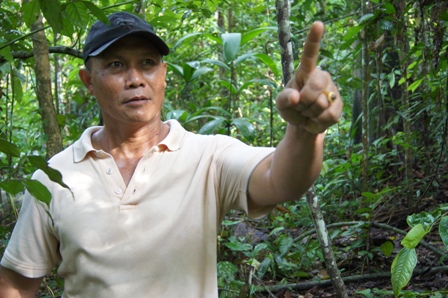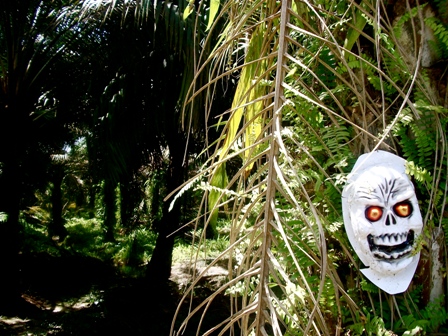East Kalimantan was once timber country, now it’s coal that rules
Klas Lundström
A future of industry? A boy inspects the river from the doorstep of his house where river boats pull up to unload.Klas Lundström |
At dawn, small freighter ships return to the port of Samarinda with loads of coal and timber from the heart of Kalimantan. The brown coal is sorted into huge piles: tons of fuel to meet the world’s demand for energy. In the port, all the coal is prepared for its journeys to Japan, China or Europe. Kalimantan’s coal – along with its palm oil and logging– contributes to Indonesia’s record-setting growth, which hit 6.5 per cent in 2011.
This is the Mahakam River, the heart of Kalimantan, the name for Indonesian Borneo. On the map the Mahakam is a winding snake, the longest river of East Kalimantan, travelling 900 kilometres from the coast to the green highlands of the interior. Today, the river is brown, filled with garbage and eroded soil from cleared forests, and it has become the highway for the coal coming from the rainforest and ending up in growing economies outside Indonesia. Fifty years ago, this water was clear; now it’s deeply stained, although the river remains the only source of washing and drinking water for thousands of people.
During the course of one hour, at least ten freighters pass by. That is the everyday view from Samarinda’s port: day after day, hour after hour. And why not? The world’s coal reserves are expected to last for at least 150 more years. ‘We sell our coal and then buy it again at more expensive prices. Mainly from China. That’s a smart move by the government, isn’t it?’ says Suryadi, a guide.
 |
Suryadi, a freelance tourist guide of 25 years, thinks the future of the Mahakam is bleak.Klas Lundström |
Life ruled by coal
During his 25 years as a freelance guide in eastern Borneo, Suryadi has witnessed how the coal mines and the palm oil plantations have changed the way of life along the Mahakam River. ‘It all began with the large scale logging’, he says.
Suryadi is 54 years old and came to Borneo when he was a small child, when the Suharto government organised poor villagers from Java and elsewhere to move to Kalimantan’s uninhabited regions to survive as small farmers. The results can be seen today: failed rice production and devastation of primary rainforests. ‘It’s very cheap to clear forest illegally near the river’, Suryadi explains. ‘You have an easy path for transportation and an easy escape if you get caught.’
Suryadi talks about a rumour: a new coal mine has opened where the Mahakam begins, a mine where debt slavery, prostitution and violence are the daily reality. The mine, called Long Top, however, has a bright future: the lack of work in many corners of Indonesia force thousands of people - mostly men - to leave home for poorly paid jobs wherever they can get them, including illegal mines. Many of those making the journey up river get stranded there, deep in debt due to high prices they must pay on basic expenses such as water, food and housing. With the distance to the outside world a multi-day journey, these costs are often double what they are elsewhere.
 |
A coal loading site on the MahakamKlas Lundström |
Making it on the river
On the boat en route to Long Bagun, where the river turns into rapids, is a 35-year-old man named Faisal. He is from Jakarta and works for the oil industry. ‘Kalimantan is the place to be when it comes to business. There are great prospects in mining – here, you find it all’, he says while lighting a cigarette.
Faisal has arrived at the heart of Mahakam River to search for new areas to explore. He travels with a man from the local logging industry and their hopes are high. Faisal doesn’t want to specify who his employer is, but he’s convinced that Kalimantan’s coal will earn him personal wealth. A coal freighter passes by, Faisal takes another puff of the cigarette, then he says to himself: ‘This is it.’
 |
Every day, thousands of tons of goods travel up and down the Mahakam to feed the booming market along its banks.Klas Lundström |
A bridge of planks marks the border between the past and the future in the village of Data Bilang. After having walked past worn and huddled shanties and reserved people, you enter a settlers’ block with new houses and curious faces. The walk not only takes you from the traditional, aging Christian community, made up of ethnic Dayaks, into the homes of recently settled Muslims from the coastal areas. The walk is also like time travel between economic realms, a journey from agriculture to commerce.
The bridge is not long – ten metres – yet the journey seems longer. Mida, a woman in her late thirties, keep the entrance of her store clean from dirt. She lives upstairs with her five children and talks about Data Bilang’s increasingly lively economy. The vast majority of her buyers are migrant workers who visit Data Bilang during the course of the day. Due to the lack of competition, she can keep prices high. The increasing number of coal mines along the Mahakam river isn’t a problem, says Mida: ‘It’s just business and that is what the people of Kalimantan ought to wish for.’
 |
Along a hidden road, palm oil workers mark trees so that they know where to continue working the next dayKlas Lundström |
On the other side of the bridge, where the Dayaks have lived since settling there in 1969, nobody talks about the future. There are empty houses and fallen shacks. Smoke rises from behind abandoned houses. Piles of trash are one of the only signs that people still live here.
‘Don't wash too close to the river’, people warn. ‘Here’s a bucket and mind your step – it’s slippery.’ Children at play are one step away from being washed away by the strong current.
There are plans to turn Data Bilang into an ‘Urban Jungle Metropolis’, a policy that has arrived at the same time as the growth of the coal business in East Kalimantan. Yet, 500 kilometres away from the coast, there is still plenty of poverty and many people have little trust in their politicians.
 |
David Villa, named after the named after the Barcelona player, takes a shower before an afternoon cockfightKlas Lundström |
Young men hope for fast cash by sending their roosters to cockfights. This morning ‘Ronaldo’, ‘David Villa’ and ‘Messi’ are having their ritual baths before the afternoon fights. Their owner is confident his roosters will prevail – and earn their owner some money. ‘Otherwise I wouldn’t bathe them’, he says with a smile.
A history of mining
The first coal mine in Kalimantan was established in 1882, near the Mahakam River, and was called Loa Kulu. The same year, oil was found. Since then, there has been hardly any turning back. According to data collected by The Mining Advocacy Network (JATAM), an NGO which maps the coal mining industry’s social and ecological consequences, there are now as many as 200 established coal mines in the region surrounding Samarinda alone.
 |
Much of East Kalimantan’s forest is gone, but there are still plenty of logging sites along the riverKlas Lundström |
The coal industry now stands on the doorstep of the city, Abdullah of JATAM confirms. But the problem, he adds, is that people don't care about the environment. ‘They care more about Facebook, celebrity gossip and iPhones. That is the challenge, to break the stalemate.’ Floods and diseases such as dengue and malaria have become common in East Kalimantan in recent years. JATAM is confident that the coal mines are to blame.
‘The cultural systems are being ruined as a consequence’, says Abdullah, ‘Borneo is being abandoned by its inhabitants and all that’s left are migrant workers and economic interests that will abandon the island and its responsibility the day the natural resources are gone.’ If things continue in the same pattern Kalimantan will be gone by 2020. ‘Both economically and ecologically’, Abdullah says and falls silent. ii
 |
Despite the environmental change, the Mahakam is still an impressive sightKlas Lundström |
Klas Lundström (klaslundstrom@live.com) is an investigative journalist and author of four non-fiction books.












